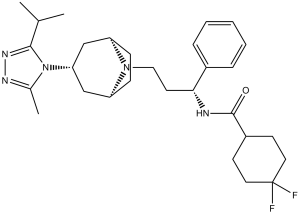Maraviroc (UK427857)
This product is for research use only, not for human use. We do not sell to patients.

For small sizes, please check our retail website as below: www.invivochem.com
| Size | Price | Stock |
|---|---|---|
| 250mg | $920 | Check With Us |
| 500mg | $1450 | Check With Us |
| 1g | $2175 | Check With Us |
Cat #: V1810 CAS #: 376348-65-1 Purity ≥ 98%
Description: Maraviroc (also known as UK-427857) is a potent, selective and non-competitive CCR5 antagonist for MIP-1α, MIP-1β and RANTES with IC50 of 3.3 nM, 7.2 nM and 5.2 nM in cell-free assays, respectively.
Top Publications Citing Invivochem Products
Publications Citing InvivoChem Products
Product Promise

- Physicochemical and Storage Information
- Protocol
- Related Biological Data
- Stock Solution Preparation
- Quality Control Documentation
| Molecular Weight (MW) | 513.67 |
|---|---|
| Molecular Formula | C29H41F2N5O |
| CAS No. | 376348-65-1 |
| Storage | -20℃ for 3 years in powder formr |
| -80℃ for 2 years in solvent | |
| Solubility In Vitro | DMSO: 100 mg/mL (194.7 mM)r |
| Water:<1 mg/mLr | |
| Ethanol: 100 mg/mL (194.7 mM) | |
| Solubility In Vivo | 2% DMSO+Corn oil: 10 mg/mL |
| Synonyms | UK427857; UK-427,857; UK-427857; UK-427,857; UK 427857; Selzentry; Celsentri; Selzentry; |
| Protocol | In Vitro | Maraviroc (UK-427857) is a selective CCR5 antagonist with potent anti-human immunodeficiency virus type 1 (HIV-1) activity. Maraviroc inhibits chemokine-induced downstream events of intracellular calcium redistribution, to MIP-1β, MIP-1α, and ICs of RTES50 The range is 7 to 30 nM. Maraviroc (UK-427857) is active against HIV-1 Ba-L, a laboratory-engineered R5 strain, at low nanomolar concentrations (IC).90), using isolated multiple (combined) donor PBMC (IC) for measurement in a 5-day antiviral assay90, 3.1 nM), single-donor PBMC (IC90, 1.8 nM) or PM-1 cells (IC).90,1.1 nM) |
|---|---|---|
| In Vivo | Clearance values for rats and dogs after intravenous administration were moderate to high (74 mL/min/kg, respectively). Maraviroc also has a moderate volume of distribution in both species (21.4 to 3.6 l/kg). The half-life value of Maraviroc is 5.0 h in rats and 9.2 h in dogs. After giving the dog orally (3 mg/kg), C.max (256 ng/mL) occurs in 1.5 hours. After administration, bioavailability is 40%. In rats, studies of concentrations obtained in the portal vein after oral administration have shown that approximately 30% of the administered dose is absorbed from the intestine |
These protocols are for reference only. InvivoChem does not
independently validate these methods.
| Solvent volume to be added | Mass (the weight of a compound) | |||
|---|---|---|---|---|
| Mother liquor concentration | 1mg | 5mg | 10mg | 20mg |
| 1mM | 1.9468 mL | 9.7339 mL | 19.4678 mL | 38.9355 mL |
| 5mM | 0.3894 mL | 1.9468 mL | 3.8936 mL | 7.7871 mL |
| 10mM | 0.1947 mL | 0.9734 mL | 1.9468 mL | 3.8936 mL |
| 20mM | 0.0973 mL | 0.4867 mL | 0.9734 mL | 1.9468 mL |
The molarity calculator equation
Mass(g) = Concentration(mol/L) × Volume(L) × Molecular Weight(g/mol)
Mass
=
Concentration
×
Volume
×
Molecular Weight*
The dilution calculator equation
Concentration(start)
×
Volume(start)
=
Concentration(final)
×
Volume(final)
This equation is commonly abbreviated as: C1 V1 = C2 V2
Concentration(start)
C1
×
Volume(start)
V1
=
Concentration(final)
C2
×
Volume(final)
V2
Step One: Enter information below
Dosage mg/kg
Average weight of animals g
Dosing volume per animal µL
Number of animals
Step Two: Enter the in vivo formulation
%DMSO
+
%
+
%Tween 80
+
%ddH2O
Calculation Results:
Working concentration:
mg/ml;
Method for preparing DMSO master liquid:
mg
drug pre-dissolved in
µL
DMSO(Master liquid concentration
mg/mL)
,Please contact us first if the concentration exceeds the DMSO solubility of the batch of drug.
Method for preparing in vivo formulation:
Take
µL
DMSO master liquid, next add
µL
PEG300, mix and clarify, next add
µL
Tween 80,mix and clarify, next add
µL
ddH2O,mix and clarify.
Note:
- (1) Please be sure that the solution is clear before the addition of next solvent. Dissolution methods like vortex, ultrasound or warming and heat may be used to aid dissolving.
- (2) Be sure to add the solvent(s) in order.




































